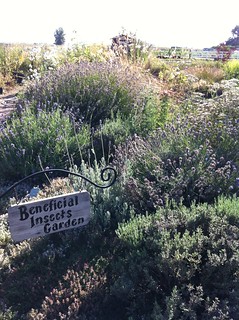Given that a few plants won't yield strong benefits to native biodiversity, what type of gardening approach can help conserve wildlife?
A new paper by Petra Lindemann-Matthies and Thomas Marty (Does ecological gardening increase species richness and aesthetic quality of a garden. Biological Conservation Volume 159,March 2013, pp 37-44) provides strong evidence that a whole gardening approach gets results.
They surveyed 36 gardens in Zurich, Switzerland, and scored them for the presence or absence of the following ecological features:
- ponds (provide habitat for amphibians, aquatic insects, aquatic plants)
- flower meadows (provide nectar and pollen to a variety of beneficial insects, and host rodents that are food for birds)
- dry walls (provide nesting sites for beneficial insects, or insects that birds feed upon)
- nettle plots (provide nectar and pollen to a variety of beneficial insects)
- nesting sites for wild bees and birds
- decomposing piles of wood (provide habitat and nesting sites for a variety of beneficial insects)
- frequency of lawn mowing
- use of synthetic fertilizers
- use of pesticides
- frequency of weeding
 |
| A 'bee barn' at the Marion Garden in Salem, OR. |
 |
| Beneficial Insect Garden at the Marion Garden ~ a demonstration garden of the Marion County Master Gardeners. |
Here is the good news! Gardens with a higher 'ecological score' were more biodiverse, took less time to manage, and were judged more aesthetically pleasing by neighbors, compared to gardens with a lower 'ecological score'.
In fact, 67% of the variation in biodiversity among gardens was a result of the 'ecological gardening score'. Only 35% of the variation in aesthetics was a function of the ecological score of each garden, which suggests that ecologically-friendly gardening practices have more of a positive impact on biodiversity, than on aesthetics.
You can learn more about ecological gardening practices by visiting Linda McMahan's ecogardening website, or by visiting an OSU Extension Master Gardener demonstration garden. Locate the garden nearest you by visiting our Google Map of OSU Extension Master Gardener activities.
View OSU Extension Master Gardener Map in a larger map
And, gardeners are often left with the impression that they can install a few native plants to support local wildlife. However, our results suggest that additions of 200-250 plants would be needed, to increase bee, butterfly or beneficial wasp richness by one species..tree nursery
ReplyDelete